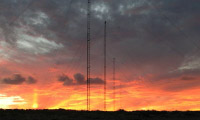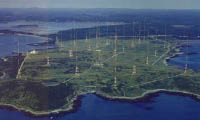Gallery of Restored Towers
VLF Towers, Naval Communication Station, Australia

The U.S. Navy uses very low frequency (VLF) radio transmissions to communicate with submerged submarines. Five on-shore VLF communication stations located around the world make-up the U.S. Naval global submarine communication system. The largest of the VLF facilities is the Naval Communication Station Harold E. Holt, located on a remote stretch of Australia’s rugged and arid northwest coast.
An array of thirteen VLF towers at Harold E. Holt Communication Station provide radio communications with submarines in the Pacific and Indian Oceans. The towers are very tall. The tallest, Tower Zero, is 1,194 feet tall and was the tallest structure in the Southern Hemisphere when it was built. The other twelve towers form two concentric rings around the central Tower Zero. The diameter of the thirteen tower array is more than 1.5 miles wide.
In 2006, Abhe & Svoboda, Inc. completed renovations of Tower Zero, and the following year renovated of another tower in the array, Tower Six. Ultrahigh-Pressure Waterjetting was used to remove the failing coating. Containments were rigged using specially designed scaffolding platforms and containments.
The project presented some interesting challenges due not only to the height of the structures and the remote location, but also the extreme environmental conditions. During the course of the project, daytime temperatures as high as 118 F were recorded and strong winds were frequent. In fact, the site is the location of strongest winds ever recorded in Australia. Nonetheless, the project was completed ahead of schedule and without incident.
An array of thirteen VLF towers at Harold E. Holt Communication Station provide radio communications with submarines in the Pacific and Indian Oceans. The towers are very tall. The tallest, Tower Zero, is 1,194 feet tall and was the tallest structure in the Southern Hemisphere when it was built. The other twelve towers form two concentric rings around the central Tower Zero. The diameter of the thirteen tower array is more than 1.5 miles wide.
In 2006, Abhe & Svoboda, Inc. completed renovations of Tower Zero, and the following year renovated of another tower in the array, Tower Six. Ultrahigh-Pressure Waterjetting was used to remove the failing coating. Containments were rigged using specially designed scaffolding platforms and containments.
The project presented some interesting challenges due not only to the height of the structures and the remote location, but also the extreme environmental conditions. During the course of the project, daytime temperatures as high as 118 F were recorded and strong winds were frequent. In fact, the site is the location of strongest winds ever recorded in Australia. Nonetheless, the project was completed ahead of schedule and without incident.
VLF Towers, Naval Communication Station, Maine

The work involved special rigging and containments for the removal of existing hazardous coatings containing PCBs, lead, and chromium, completely recoating all the tower structural steel, replacement of bolts, hand-railing and grating modification, and replacement of tower lighting systems.
The hazardous coating removal and surface preparation on the tall towers and counterweight towers was performed with ultrahigh-pressure water jetting equipment. These units utilized water at pressures in excess of 36,000 psi to remove the coating without damaging the existing galvanizing.
The hazardous coating removal and surface preparation on the tall towers and counterweight towers was performed with ultrahigh-pressure water jetting equipment. These units utilized water at pressures in excess of 36,000 psi to remove the coating without damaging the existing galvanizing.
